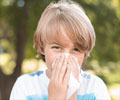Lowering exposure to allergens from mice may lead to improved lung growth for children with asthma living in low-income neighborhoods, helping them avoid lung ailments.

‘All children involved in the study tested positive beforehand for mouse allergy, had high levels of mouse allergens in their homes.’
Read More..




Asthmatic children who reside in low-income neighborhoods often live amid mouse-allergen-laden dust caused by unaddressed rodent infestations. Matsui's research team tracked 350 low-income, mostly minority children ages five to 17 for a year and found a strong association between mouse allergen exposure and lung function growth.
Read More..
"This study has important implications for children with asthma living in homes that are in poor physical condition, which promotes mouse infestation and similar problems with other pests, such as cockroaches," she said. "It suggests that these exposures could cause ongoing lung damage, putting them at greater risk of decreased lung health in adulthood."
Lower lung function among adults is a risk factor for COPD (chronic obstructive pulmonary disease) and a shorter lifespan, so it's possible that this exposure has implications for longevity, though this was not a finding from the current study, Matsui added.
The study suggests reducing indoor allergen exposure "could produce long-term lung function growth benefits in children similar to benefits seen from improvements in air pollution."
All children involved in the study tested positive beforehand for mouse allergy, had high levels of mouse allergens in their homes, and had experienced uncontrolled asthma leading to an emergency room or urgent care visit, overnight hospital stay or oral steroid burst treatment during the previous 12 months. In some low-income neighborhoods, as many as half of children with uncontrolled asthma are allergic to mice and have high levels of mouse allergens in their homes.
Advertisement
Follow-Up Studies
Advertisement
Another is to see whether the findings apply to other allergens from sources such as cockroaches, pets, dust mites, mold and pollutants such as secondhand smoke. A third study idea is to test and assess various ways to sustainably reduce mouse allergen exposure.
More broadly, future research should focus on the population health implications of poor housing conditions.
"What are the long-term population effects of living in poor housing conditions that promote pest infestations on lung health?" Matsui asked. "And if there are long-term population effects, as suggested by this study, what are effective strategies for mitigating these effects?"
Source-Eurekalert














